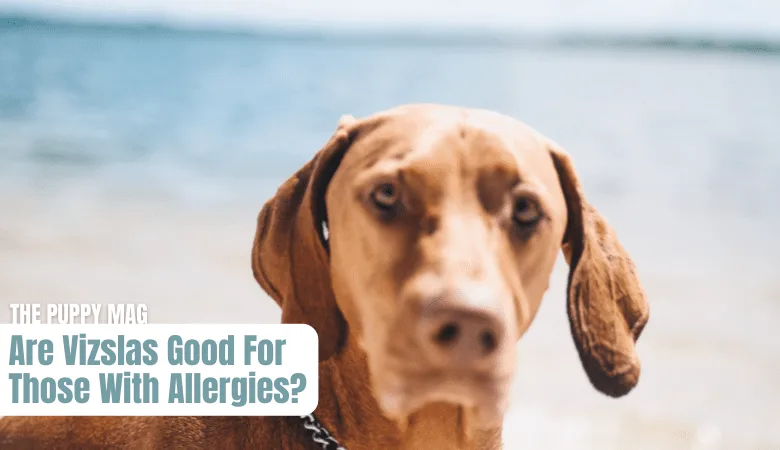If you are an allergy sufferer, you may be searching for a canine companion that won’t lead to constant flare-ups. With Vizslas having such a short coat, many wonder if this breed is more allergy-friendly than other furry friends. So are Vizslas good for people with allergies?
In this article, we will discuss the details of hypoallergenic dogs, and help you determine if a Vizsla is the right breed for you!
Vizslas are a good choice for allergy sufferers, but they are not hypoallergenic. In fact there is no dog breed that is truly hypoallergenic. Still, Vizslas have a short coat and do not produce much dander compared to other breeds, this can make them more appropriate for those with dog allergies.

Table of Contents
Are There Any Hypoallergenic Dog Breeds?
Before we dive into the details of whether or not Vizslas are ideal for allergy sufferers, it’s important to first discuss the term ‘hypoallergenic’ when referring to dogs. Though this term is all the rage these days, there is no such thing as a hypoallergenic dog breed.
Dogs are often considered hypoallergenic when they shed less than other breeds. While this can certainly be a bit easier on those with sensitivities to canine dander, it’s important to realize that fur is not the only cause of allergies in humans.
When a person is allergic to dogs, they also have reactions to certain proteins in a dog’s saliva. These proteins can find their way onto surfaces around your home, on your skin, and even throughout your dog’s fur. This means that no matter how little a dog sheds, allergy sufferers can still be affected.
Are Vizslas Good For Allergy Sufferers?
Though there is no such thing as a hypoallergenic dog, there may be some breeds that produce less pet dander than others. Unfortunately for our Vizsla lovers with pet allergies, this breed does not fall into that category.
Though Vizsla hair is shorter than many other dog breeds, they do not shed any less. Vizslas tend to shed regularly throughout the year, leaving behind a fine dust of fur in their path. Their fur is often not as visible on furniture items around your home, but it still exists.
Vizslas may shed just as often as other canine friends, but there are ways to decrease the amount of pet dander around your home. Vizslas are certainly not off-limits to those with pet allergies, as long as you are willing to put in a bit of extra work!
Recommended read: Male vs Female Vizslas: The KEY Differences
4 Ways To Decrease Allergies With A Vizsla
As we mentioned above, there are ways to ease your pet allergies when living with a Vizsla. To help you better enjoy your time spent with your canine companion, let’s discuss some of our favorite allergy-reducing tips below!
1. Designate An Allergy-Free Room
If you are someone that suffers from pet allergies, it’s important to have an area in your home that is free of any potential triggers. Allergies can flare up from time to time, making it helpful to have an escape zone when needed.
You can create an allergy-free zone by prohibiting your pet from accessing the area, and making sure their pet dander does not come in contact with any items within this room. You can also take it up a notch by keeping a HEPA air purifier in the room as well.
2. Use HEPA Air Purifiers
Keeping air purifiers around your home can help to limit the pet dander present in the environment, as well as filter out any other potential allergens. It’s recommended to have one air purifier per room or at least one present in the room you inhabit most frequently.
3. Clean Frequently
If pet dander is your allergy trigger, you will want to remove as much dander from around your home as possible. You can do this by vacuuming frequently, frequently washing all bedding your pet comes in contact with, dusting regularly, and regularly cleaning any surfaces your pup drools on.
4. Frequent Bathing With Gentle Shampoo
Frequent bathing is another way to potentially decrease any allergy flare-ups around your Vizsla. Though it’s not recommended to bathe your dog more than once a month, there are some exceptions for situations like this.
If you choose to wash your Vizsla more than once a month, we always suggest speaking with your vet about the best shampoos for the job. Some shampoos can strip the skin of their natural oils, so you will want to be sure that you are always using a gentle shampoo option.
Related article: 9 Things you must know BEFORE getting a vizsla!
FAQs
Can you be allergic to Vizslas?
If you have a pet allergy with high sensitivity then it’s possible a vizsla will cause a reaction. Despite their short coat, they do still shed a little and produce dander, which is the main trigger behind allergic reactions
Do Vizslas have dander?
Yes, vizslas produce dander as all breeds do. Dander is essentially just tiny, even microscopic pieces of dead skin. This is the main trigger behind allergic reactions, not the hair itself.
Are Vizslas hypoallergenic?
No, vizslas are not hypoallergenic. There is actually no breed that’s truly hypoallergenic, as shed skin and hair to some extent. Vizslas may be a better choice for those with allergies than other breeds, however.
Are Vizslas good for pet allergy sufferers?
Although vizslas do still shed and produce dander, they may be a better breed for allergy sufferers than others. In general, vizslas produce less dander than many other breeds.
Final Thoughts
Vizslas may not be hypoallergenic, but it is possible to limit any potential allergens when they are present. Be sure to review the information we discussed above, and you can create an allergy-free home going forward!
Thank you for reading! Back to more Vizsla articles >>>
